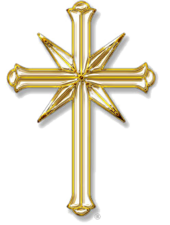
The Scientology cross is one of the principal symbols of Scientology. It is most often used to represent the Church of Scientology. The cross bears some resemblance to the Christian cross but differs from it with the addition of four diagonal rays between the conventional horizontal and vertical arms. The eight points of the cross represent the eight dynamics in Scientology, the eight divisions of urges towards survival:
- One's self as an individual
- Sex, procreation, family
- Groups, society, community
- Species survival (humankind)
- Life forms in general
- The physical universe: matter, energy, space & time
- Spirits (self or others as a spiritual being)
- Infinity or Supreme being
According to Ability magazine, a sand casting presenting a cross was dug up by L. Ron Hubbard in the mid-1950s, the model of which “came from a very ancient Spanish mission in Arizona”. This cross came to be the new minister insignia besides the formal ceremonial medallion and ribbon. He also occasionally referred to it as the “sunburst cross”. Scholars speculate the Scientology cross may have been inspired by Aleister Crowley’s use of the Rose Cross.

The practice of prominently displaying the cross in Scientology centers was instituted in 1969 following hostile press coverage in the United Kingdom and elsewhere, when Scientology’s status as a legitimate religion was being questioned. In response, Hubbard ordered that, “Any staff who are trained at any level as auditors (but not in AOs) are to be clothed in the traditioned ministerial black suit, black vest white collar silver cross for ordinary org wear.”
See also
References
- Urban, Hugh B. (2011). The Church of Scientology: A History of a New Religion. Princeton University Press. ISBN 9780691146089.
- "New Minister Insignia" (PDF). Ability (14): 13. 1955.
The model of the cross came from a very ancient Spanish mission in Arizona, a sand casting which was dug up by Ron. The cross is a regular Roman cross with four additional short points between the four long points, a true eight-dynamic Scientology cross.
- Hubbard, L. Ron (1976). "Operational Bulletin No. 5". The Technical Bulletins of Dianetics and Scientology: Volume II 1954-1956 (PDF). Scientology Publications. p. 294. ISBN 9788787347822. Archived from the original (PDF) on April 21, 2018.
A Sunburst Cross and lapel pin will cost 8 gns. The cross is a lovely thing of pure silver about three inches high, hung with a plain silver chain from the crossbar. It is worn with any collared shirt or dress about the throat, a distinctive badge.
- Urban, Hugh (2012). "The Occult Roots of Scientology?". Nova Religio: The Journal of Alternative and Emergent Religions. 15 (3): 105-6. doi:10.1525/nr.2012.15.3.91.
A second, even more obvious borrowing from Crowley and the Golden Dawn was Hubbard's choice of the eight-pointed Scientology cross as the key symbol for his new church. As many observers have pointed out, Hubbard's cross seems to be closely modeled on the Golden Dawn cross, which also adorned the back of every card in Crowley's famous "Thoth" tarot deck, one of the most influential and widely used tarot decks to this day. Even though Hubbard's theological explanation of the image was very different, there seems to be little doubt that the eight-pointed Scientology cross, still today the central symbol of the church, is taken from the Golden Dawn/Crowley Rosy Cross.
- Hubbard, L. Ron (1999). "HCO Policy Letter of February 1969: Religion". An Encyclopedia of Scientology Policy (PDF). Los Angeles: Church of Scientology of California. p. 196. ISBN 0-88404-031-3. Archived from the original (PDF) on September 22, 2019.
Any staff who are trained at any level as auditors (but not in AOs) are to be clothed in the traditioned ministerial black suit, black vest white collar silver cross for ordinary org wear.
